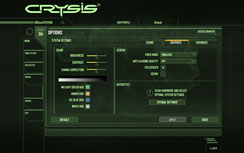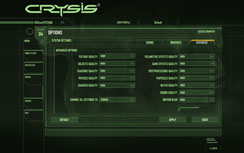Crysis
Publisher: Electronic ArtsCrysis is seen by many as the poster boy for DirectX 10 and it will make your system cry, quite literally – it’s a monster! It doesn’t come as much of a surprise then, that the graphics are something special – they’re above and beyond anything we’ve ever seen in a PC game.
We tested the game using the 64-bit executable under DirectX 10 mode with the 1.21 patch applied. We used a custom timedemo recorded from the Laws of Nature level which is more representative of gameplay than the built-in benchmark that renders things much faster than you're going to experience in game. We found that around 27-33 fps in our custom timedemo was sufficient enough to obtain a playable frame rate through the game. It's a little different to other games in that the low frame rates still appear to be quite smooth.
We set all of the in-game details to High and forced 8x anisotropic filtering in the driver menu as there is currently no support for it in game. We tested at 1,280 x 1,024, using 0x, 2x and 4x anti-aliasing, 1,680 x 1,050 using 0x and 4xAA, 1,920 x 1,200 using 0x and 2xAA and 2,560 x 1,600 with 0xAA and 2xAA. By extensively testing using anti-aliasing in very high resolutions in conjunction to Very High quality, we'll be pushing even the bleeding edge hardware on test to the limit.
It comes as no surprise to see the Nvidia cards perform better than the competition from AMD in Crysis, but it’s not as clear cut as one would have expected between the brand new Radeon HD 4770 and Nvidia’s GeForce 9800 GT. Yes, for the most part, the GeForce 9800 GT is the faster card in Crysis, but it’s not by any meaningful margin when the frame rates are remotely close to playable.
Admittedly, to play Crysis with a smooth frame rate, you’re going to have to knock down the details on both the Radeon HD 4770 and the GeForce 9800 GT, but there’s no reason why the game can’t be playable at 1,280 x 1,024 2xAA 16xAF with most of the details set to ‘high’. Some of the more demanding settings will, of course, have to be turned down though in order to boost performance, but a solid 30 frames per second isn’t out of the question.
If, however, you want to play Crysis with all of the in-game details set to high, you’re going to need at least a
It's worth noting that there were a few instances where the GeForce 9600 GSO refused to run Crysis without crashing. Since these scenarios only popped up with high levels of anti-aliasing enabled, we're assuming it's a memory related issue. That said, the GeForce 9600 GSO is a fairly mid-range proposition for a gamer (it fares much better if you only look at Folding performance), so it's not entirely unexpected to see this.

MSI MPG Velox 100R Chassis Review
October 14 2021 | 15:04











Want to comment? Please log in.